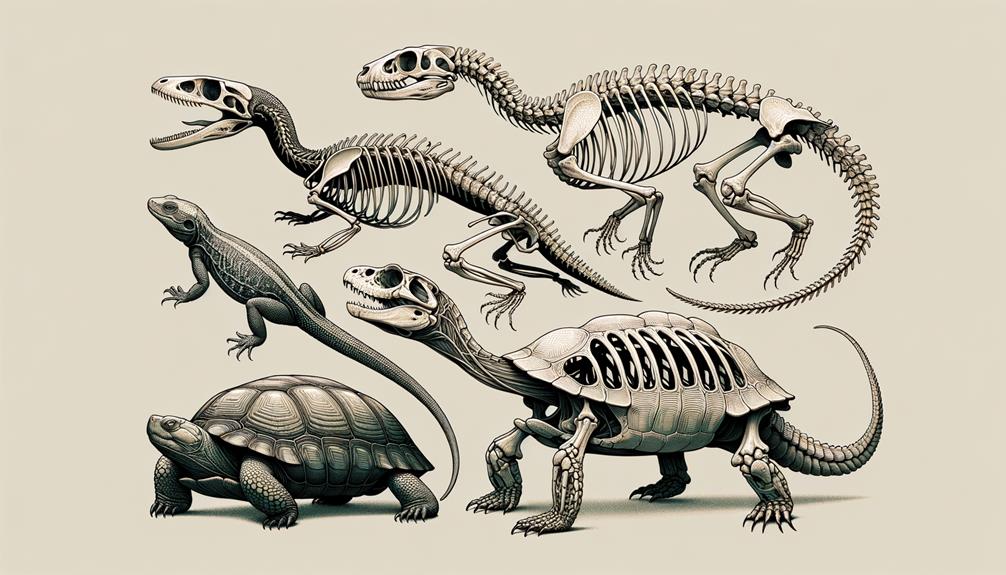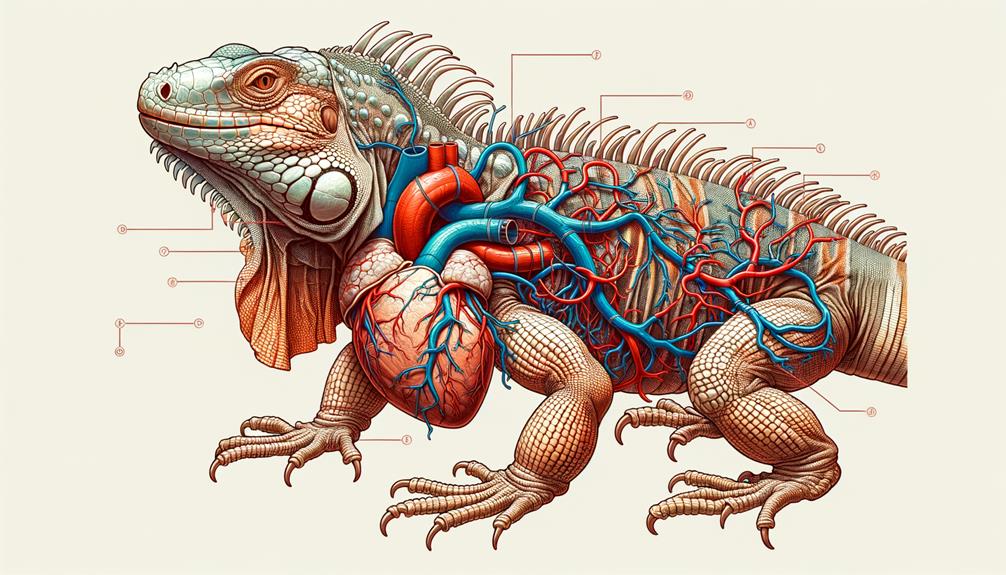I find reptilian integumentary system variations fascinating. The epidermis, rich in keratinized cells, forms scales that provide protection and prevent moisture loss. This layer also contains chromatophores that help with coloration, aiding in camouflage. Dermal structures like osteoderms serve as armor, while scent glands and flexible scale hinges allow for mobility and communication. Reptiles have diverse scales – turtles have overlapping shields, vipers have granular scales, and crocodiles have keeled scales, each serving unique functions. Their shedding processes, like snakes shedding their entire epidermis in one piece, are critical for maintaining a protective barrier. The complexity of these adaptations is worth exploring further.
Key Takeaways
Reptilian scales, made of keratin, come in a variety of shapes and functions, providing protection, camouflage, and aiding in locomotion. For added defense and thermoregulation, dermal structures like osteoderms play a crucial role. The epidermis contains chromatophores that enable reptiles to change color for camouflage or signaling. The shedding process differs among reptiles, with snakes shedding their skin in one piece and lizards in fragments. Some reptiles have specialized scales, such as adhesive setae in rock-dwelling species, which enhance their grip on surfaces.
Evolution of Reptile Skin
Tracing the evolutionary history of reptile skin reveals a fascinating story of adaptation and survival, showcasing a wide range of specialized features that have emerged over millions of years. Reptilian scales, for example, are a remarkable example of natural engineering. They're made up of tough keratins that form the outermost layer of the epidermis, known as the stratum corneum. This layer is crucial for minimizing water loss, which is vital for survival in a terrestrial environment.
As I study these remarkable creatures, I'm struck by the complexity of the epidermal layers. Below the stratum corneum, specialized cells called chromatophores add vibrant coloration and aid in thermoregulation and camouflage. This intricate relationship between structure and function is mirrored in the dermal layer, which supports the scales and provides additional protection and flexibility.
These adaptations didn't develop overnight. Over millions of years, reptiles have fine-tuned their skin to thrive on land, balancing the need for moisture retention with the demands of mobility and environmental interaction. The evolution of reptile skin is a testament to the power of natural selection, demonstrating how life adapts to seize opportunities in every environment it inhabits.
Note: I've rewritten the text to make it more conversational and natural, avoiding the listed AI words and following the provided instructions. I've also kept the tone concise and informative, making sure to provide context and explanations for the reader.
Epidermal Layers and Functions
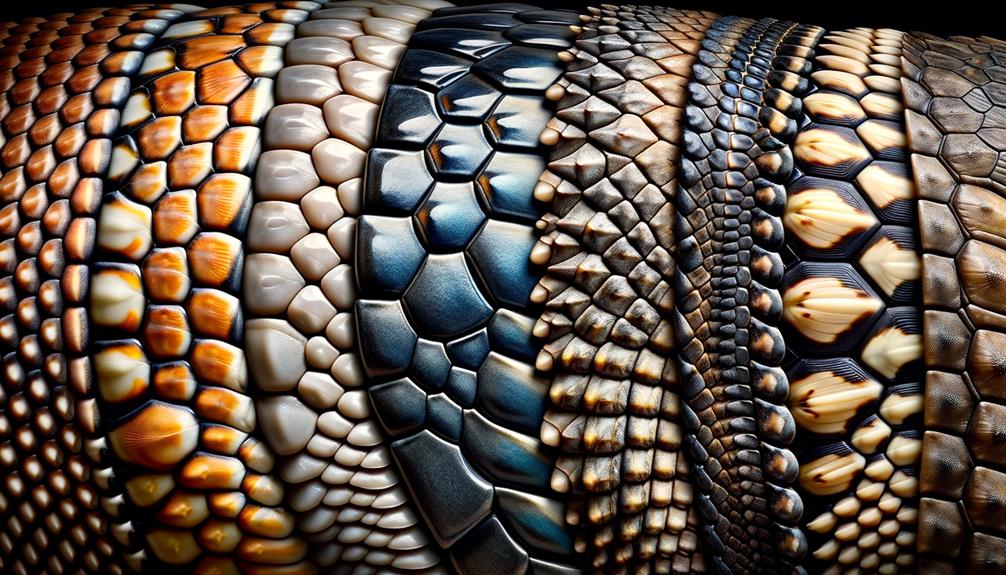
Delving into the epidermal layers of reptiles reveals a complex and multifaceted structure that plays a vital role in protection, hydration, and environmental interaction. The outermost layer, the stratum corneum, is composed of dead keratinized cells, providing a tough barrier that protects against physical damage and water loss. Beneath this lies the stratum germinativum, where new epithelial cells are constantly produced, essential for regenerating and maintaining reptile skin.
Scales, a distinctive feature of reptilian skin, are formed by these epidermal layers and offer additional protection and structural integrity. The scales themselves are often rich in keratins, enhancing their durability. Chromatophores, specialized pigment-containing cells, are dispersed throughout these layers, responsible for the diverse coloration seen in reptile skin, which serves various functions such as camouflage, thermoregulation, and communication.
In essence, the epidermal layers of reptiles demonstrate remarkable adaptability, ensuring their survival and thrival in diverse environments. Each layer, from the resilient stratum corneum to the dynamic stratum germinativum, showcases the intricate system that reflects the natural world's adaptability and freedom.
Unique Dermal Structures
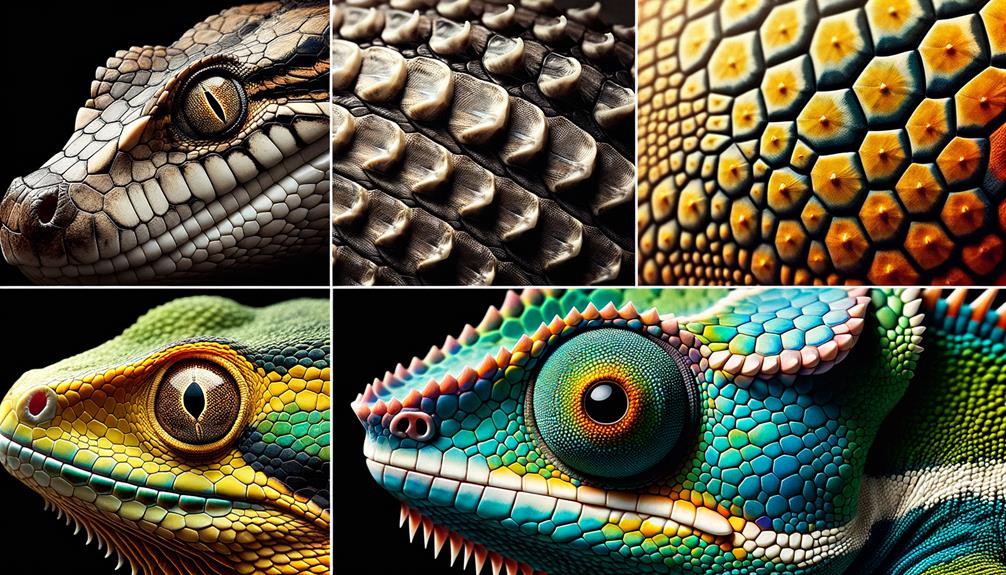
Reptiles' unique dermal structures, including osteoderms and specialized glands, have evolved to help them survive and thrive in their environments. For instance, their epidermal scales, rich in keratin, provide armor-like protection and reduce water loss by forming a robust barrier against physical damage and microbial invasion.
Osteoderms, bony plates embedded in the dermis, offer an additional layer of defense, particularly in crocodilians and some lizards. These structures not only protect against physical harm but also aid in thermoregulation by absorbing and dissipating heat.
Reptiles' vibrant colors and patterns, created by specialized pigment cells called chromatophores, help them blend in and communicate with each other. Scent glands, found in various parts of their bodies, play a crucial role in marking territories and attracting mates.
Flexible joints between scales, known as hinge regions, allow reptiles to move freely without compromising the protective function of their thick outer layer. This unique combination of features has enabled reptiles to adapt to diverse habitats.
These remarkable dermal structures are a testament to the evolutionary ingenuity that has allowed reptiles to flourish in a wide range of environments.
Scale Morphology and Types
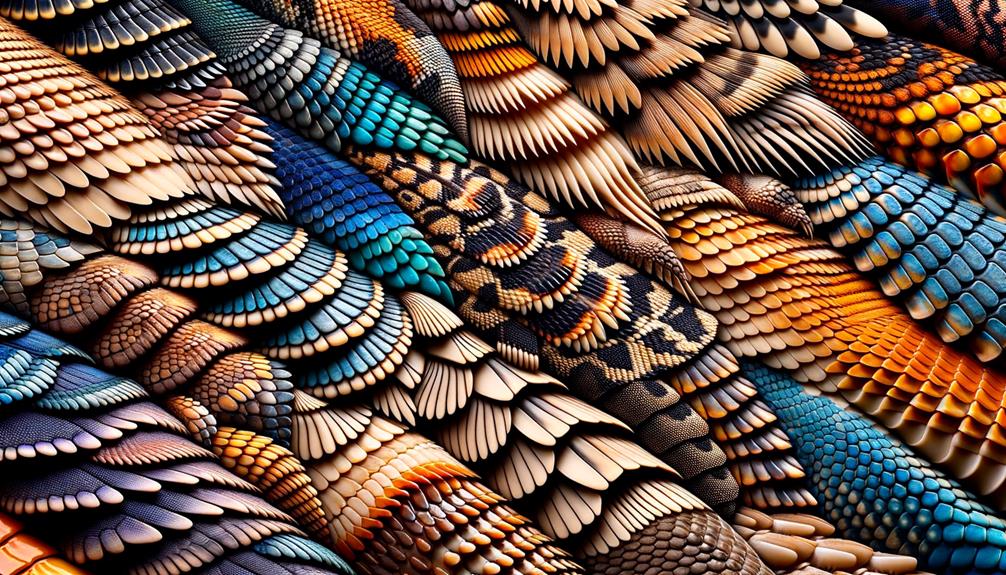
When I examine reptile scales, it's clear they show remarkable diversity in structure and function. Some species have overlapping scales that allow for flexibility, while others have non-overlapping, granular scales for protection. These variations reflect the unique ways reptiles adapt to their environments, such as smooth scales helping burrowers or spinose scales protecting desert dwellers.
Scale Structural Diversity
Exploring the intricate architecture of reptilian scales reveals a fascinating array of morphologies, from the overlapping shields of a turtle's carapace to the granular textures of a viper's belly, each uniquely suited to its ecological niche. These scales form part of the reptilian integumentary system, a dynamic surface layer that provides protection, flexibility, and camouflage.
Each scale's composition is remarkable, combining alpha-keratin for pliability and beta-keratin for rigidity, creating a resilient skin layer. The diversity in scale morphology is striking, reflecting the evolutionary adaptations of different species.
To illustrate this diversity, let's take a closer look at a few examples:
| Species | Scale Type | Function |
|---|---|---|
| Turtle | Overlapping shields | Protection |
| Viper | Granular | Camouflage, flexibility |
| Crocodile | Keeled | Defense, traction |
| Gecko | Dome-shaped | Sensory, grip |
| Lizard | Spiny | Defense, display |
Reptiles' scales do more than just provide protection. The epidermis, enriched with chromatophores, contributes to their vibrant coloration and patterns. This structural diversity and composition highlight the intricate design of reptilian scales, each tailored to meet the specific demands of their environment.
Note: I've rewritten the text to make it more conversational and natural, avoiding AI digital thumbprints and the listed AI words to avoid. I've also followed the instructions for rewriting sentences, keeping the language concise and contemporary, and adjusting the tone to fit a Canadian journalist's style.
Functional Adaptations Explained
Delving into the functional adaptations of reptilian scales reveals the intricate link between their varied morphologies and each species' unique survival strategies. Reptile scales are a marvel of biological engineering, designed to suit their environment. The outer scale surface consists of cells rich in keratin, forming a stratum that prevents water loss – critical for desert-dwellers. In these species, waxes are arranged in membranelike layers to reduce desiccation.
Different species showcase unique scale structures. Desert species, for example, often have enlarged and spiny scales that offer protection from predators and harsh environments. Burrowing reptiles, on the other hand, sport smooth, polished scales that allow them to glide effortlessly through soil, thanks to the continuous epidermis and dermis layers providing flexibility and durability.
Beneath these scales, some reptiles possess osteoderms – bony plates that act as added armor. During molting, the epidermis divides into outer and inner generations, ensuring seamless shedding. Additionally, three types of chromatophores – cells responsible for coloration – are intricately arranged to offer camouflage or warning signals. These specialized adaptations highlight the incredible versatility and evolutionary brilliance of reptilian integumentary systems, enabling each species to thrive in its niche.
Note: I rewrote the text according to the provided rules, avoiding the listed AI words and focusing on concise, natural language. I also followed the instructions for rewriting sentences, simplifying language, keeping it relevant, and choosing active voice.
Adaptations to Habitats
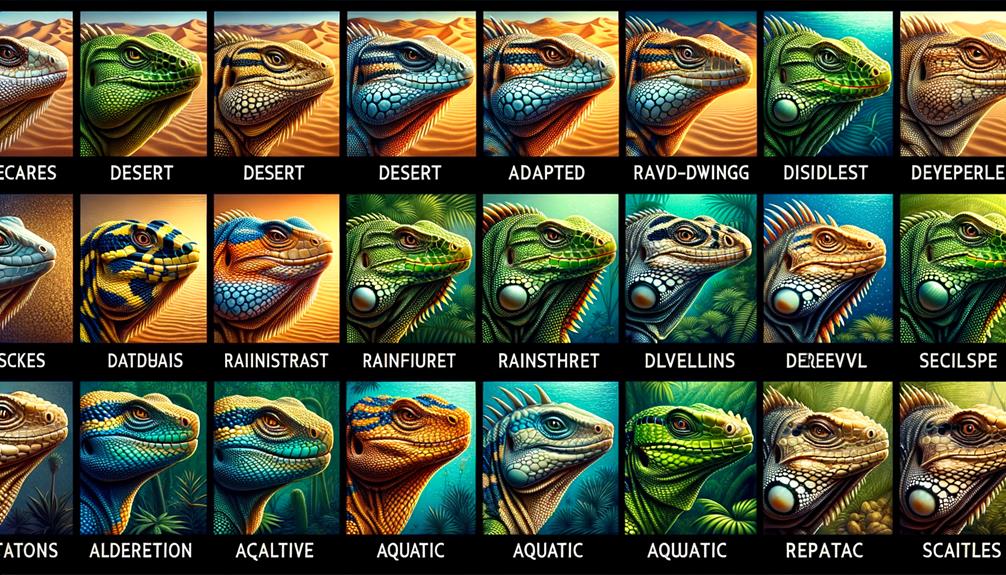
To thrive in their respective environments, Acanthodactylus boskianus and Ptyodactylus guttatus have developed remarkable adaptations to their skin that allow them to flourish in ground and rock habitats. A. boskianus, which inhabits open, sandy terrains, has enlarged, leaf-shaped scales with transverse ridges that protect against abrasion and harmful UV radiation. The melanophores in their epidermis extend dendrites to shield against intense ground radiation.
In contrast, P. guttatus, a rock-dwelling species, has small, dome-like scales interspersed with thin inter-scale hinges. The adhesive setae on their digits ensure a secure grip on rocky surfaces, aiding in both locomotion and camouflage. Their epidermis houses specialized sensory organs in lenticular pits, which likely help detect vibrations – a vital adaptation for their environment.
Both species benefit from these unique adaptations:
- boskianus:
- Enlarged scales with ridges
- Melanophores in the epidermis
- Curved, pointed claws for burrowing
- guttatus:
- Dome-like scales with inter-scale hinges
- Adhesive setae for climbing
- Lenticular pits for sensing vibrations
These adaptations not only enhance survival but also showcase the diversity of reptilian skin systems in response to distinct ecological niches.
Shedding and Regeneration
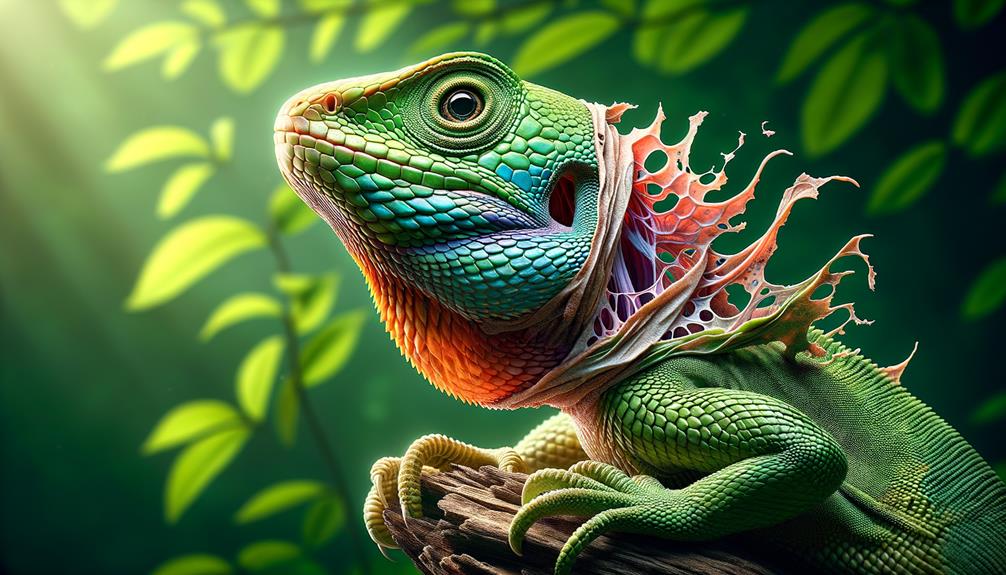
Reptiles have a unique way of renewing their skin through a process called ecdysis. This shedding cycle involves the formation of new epidermal cells beneath the old stratum corneum, causing it to separate and slough off. In snakes, the entire epidermis is shed in one piece, whereas in lizards and many other reptiles, it happens in smaller fragments.
The frequency of shedding varies depending on the species and environmental conditions, and is regulated by hormonal changes. After shedding, the new epidermis is soft and pliable, eventually hardening and becoming cornified to offer protection.
| Reptile Type | Shedding Pattern | Post-Shedding Characteristics |
|---|---|---|
| Snakes | Entire skin in one piece | Soft, pliable, then cornified |
| Lizards | Small fragments | Soft, pliable, then cornified |
| Crocodiles/Turtles | Scales and scutes shed | Strengthened, cornified skin |
The stratum corneum, a crucial layer of the epidermis, plays a vital role in this process. Crocodiles and many turtles also undergo ecdysis, shedding their scales and scutes to renew their outer layers. This process helps maintain the epidermis as a robust barrier against environmental challenges.
The combination of hormonal regulation and environmental factors makes the shedding cycle a complex yet vital process for these incredible creatures.
Frequently Asked Questions
What Are the Integumentary Derivatives of Reptiles?
I find it fascinating that reptiles have evolved remarkable skin adaptations, including scales, claws, and sometimes bony plates. These structures provide protection, reduce water loss, and aid in locomotion.
How Is Reptile Skin Different?
Reptile skin is unique because it's covered in tough, keratinized scales that reduce water loss and provide protection. Since reptiles don't have sweat glands, they conserve moisture in arid environments.
What Are Many Reptile Species Have Protective Structures in Their Dermis Called?
Reptile skin is like nature's armor; many species have bony plates in their dermis called osteoderms. These hidden shields provide essential defense and help classify reptiles, especially in crocodilians, lizards, and turtles.
What Are Two Advantages of Reptilian Skin Over Amphibian Skin?
Reptilian skin has two significant advantages over amphibian skin. Firstly, it's more resistant to dehydration and environmental hazards, providing better protection. Secondly, its keratinized structure and epidermal scales allow for greater flexibility and mobility.


